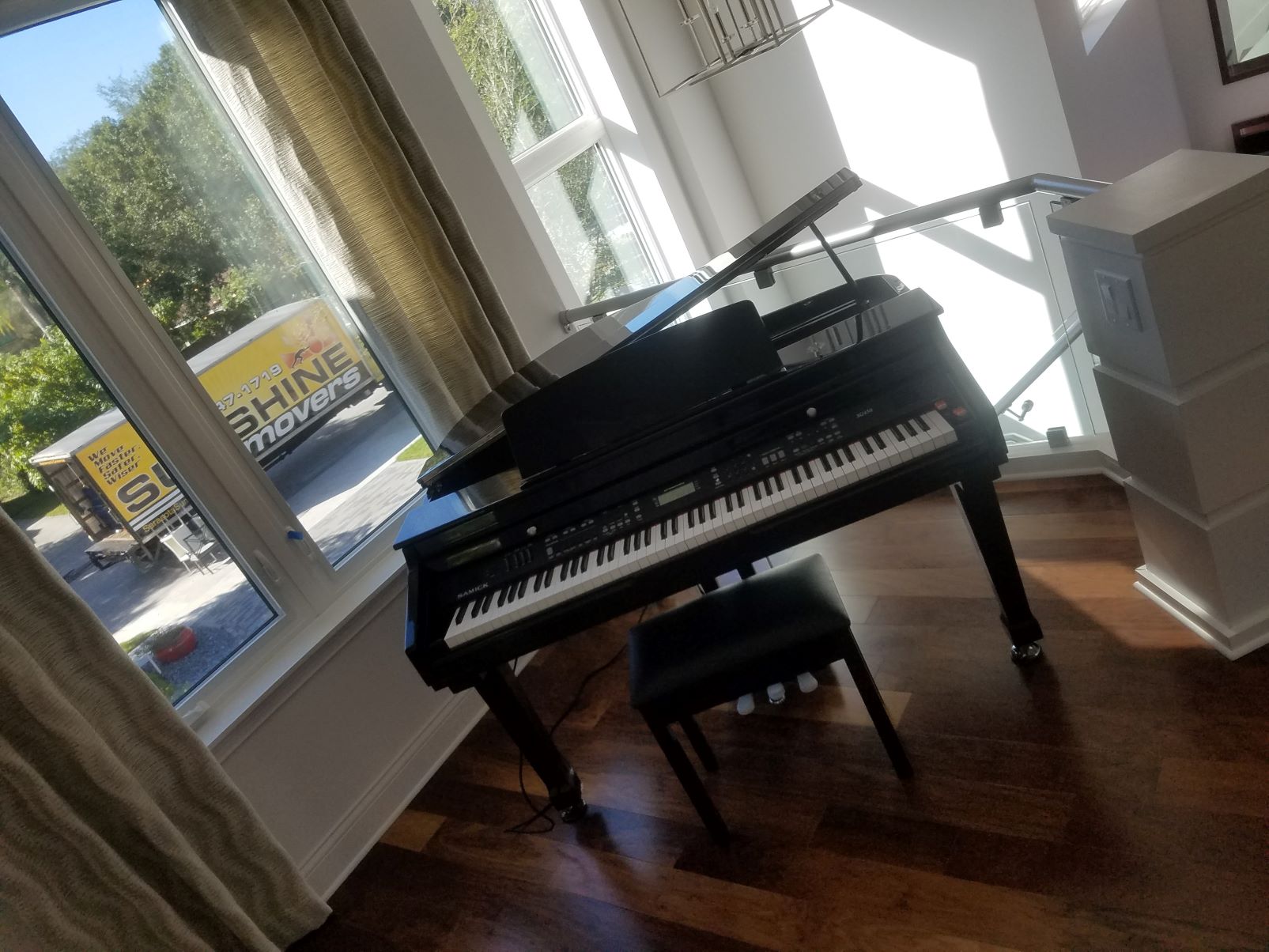Home>Production & Technology>Background Music>How To Take Out Background Noise Without Taking Out Background Music


Background Music
How To Take Out Background Noise Without Taking Out Background Music
Published: October 28, 2023
Learn how to remove background noise without affecting your background music. Improve your audio quality and create professional-sounding videos.
(Many of the links in this article redirect to a specific reviewed product. Your purchase of these products through affiliate links helps to generate commission for AudioLover.com, at no extra cost. Learn more)
Table of Contents
Introduction
Background music plays a crucial role in setting the tone and atmosphere of any audio or video production. Whether it’s a film, a podcast, a YouTube video, or a commercial, the right background music can significantly enhance the overall experience for the audience.
However, capturing high-quality audio without any unwanted background noise can be a challenge. Factors such as environmental noise, electrical interference, and equipment limitations can all contribute to the presence of unwanted noise in recordings. The challenge then becomes finding effective methods to reduce background noise without compromising the quality and integrity of the background music.
In this article, we will dive into the techniques and strategies that can be employed to take out background noise without affecting the background music. From adjusting equalization and utilizing noise gates to applying dynamic range compression and spectral editing, we will explore various methods to achieve the desired results.
By understanding and implementing these techniques, content creators, filmmakers, podcasters, and musicians can ensure that their background music remains clear, impactful, and free from distracting noise. So, let’s delve into the world of noise reduction and discover how to strike the perfect balance between background noise and background music.
Understanding the Challenges
Before delving into the techniques for removing background noise while preserving background music, it’s essential to understand the challenges involved in this process.
One of the main challenges is distinguishing between the background music and the unwanted noise. This is particularly relevant when the noise and music share similar frequency ranges. Tackling this challenge requires careful analysis and understanding of the characteristics of the noise and the music to effectively separate the two.
Another challenge arises when attempting to remove background noise without negatively impacting the quality and clarity of the background music. Overaggressive noise reduction can result in a loss of details and dynamic range, making the music sound dull and unnatural. Striking the right balance between reducing noise and preserving the musical elements is crucial.
Furthermore, different types of audio recordings present unique challenges when it comes to noise reduction. For example, live recordings of concerts or performances often have ambient noise from the audience or the venue, which needs to be minimized while keeping the music intact. On the other hand, recordings in controlled studio environments may face electrical interference or equipment noise.
Lastly, it’s worth noting that the effectiveness of noise reduction techniques can vary depending on factors such as the quality of the equipment used, the expertise of the person implementing the techniques, and the specific characteristics of the noise source.
By understanding these challenges, content creators and audio engineers can adopt a more informed approach to address background noise issues while ensuring the background music remains pristine. In the following sections, we will explore various techniques that can help overcome these challenges and achieve desirable results.
Effective Noise Reduction Techniques
When it comes to removing background noise while preserving background music, several techniques can be employed to achieve optimal results. Let’s explore some of the most effective noise reduction techniques:
- Adjusting Equalization: One of the simplest ways to reduce unwanted noise is by adjusting the equalization (EQ) settings. Using a graphic or parametric EQ, you can identify the frequency ranges where the noise is most prominent and reduce those frequencies. Care should be taken to avoid affecting the frequencies of the background music.
- Using Noise Gates: Noise gates act as a virtual “gate” that opens to allow the background music to pass through when it reaches a certain level, and closes to cut off the audio during moments of silence or when the volume drops below a designated threshold. By setting the noise gate appropriately, you can eliminate or significantly reduce background noise during silent periods.
- Applying Dynamic Range Compression: Dynamic range compression is a technique used to control the varying volume levels in audio. By compressing the dynamic range of the audio, quieter parts can be amplified, making them more audible, while louder parts can be attenuated to prevent distortion. This technique can help reduce the prominence of background noise without compromising the overall volume and clarity of the background music.
- Utilizing Spectral Editing Tools: Spectral editing tools offer more advanced noise reduction capabilities by allowing precise editing of specific frequency ranges. These tools enable you to select and reduce the amplitude of the noise components while leaving the background music relatively untouched. Spectral editing can be useful for more challenging noise sources that are difficult to remove using conventional techniques.
It’s important to note that the effectiveness of these noise reduction techniques may vary depending on the specific audio recording and the nature of the noise. Experimentation and fine-tuning are often necessary to find the optimal settings and achieve the desired results without sacrificing the quality of the background music.
Throughout the process, it’s recommended to listen critically to the audio and make adjustments accordingly. It’s also advisable to utilize high-quality audio editing software that provides precise control over the noise reduction parameters and offers real-time preview options to assess the impact on the background music.
By employing these noise reduction techniques, content creators and audio engineers can significantly improve the quality and clarity of audio recordings by reducing or eliminating background noise while preserving the integrity of the background music.
Adjusting Equalization
One of the key techniques in removing background noise while preserving background music is adjusting the equalization (EQ) settings. EQ allows you to control the balance of frequencies in the audio, making it a valuable tool for reducing unwanted noise.
When adjusting the equalization, it’s important to identify the frequency ranges where the background noise is most prominent. This can be achieved through careful listening and analysis of the audio. Once the frequency ranges are identified, you can use a graphic or parametric EQ to reduce those specific frequencies.
Start by opening the EQ plugin in your audio editing software. If you’re using a graphic EQ, you’ll have access to sliders that represent different frequency bands. If you’re using a parametric EQ, you’ll be able to adjust specific frequency ranges.
Listen to the audio and pay attention to the parts where the background noise is most noticeable. Use the EQ sliders or parameters to reduce those frequencies. It’s important to strike a balance between reducing the background noise and maintaining the natural sound of the background music. Avoid overdoing the reduction, as it may result in a thin or unnatural sound.
Another useful technique is to use a high-pass filter to eliminate low-frequency rumble or noise. This is particularly effective for removing consistent background noise such as air conditioning units or electrical hum. By setting the high-pass filter to a frequency slightly below the lowest frequency of the background music, you can eliminate these low-frequency noise sources without affecting the music.
It’s worth mentioning that different types of background noise may have different frequency characteristics. For example, wind noise may be predominantly in the higher frequency range, while electrical interference may manifest as intermittent spikes across various frequencies. By using the EQ tool effectively, you can target and reduce these specific frequencies.
Throughout the process, it’s important to listen to the audio with critical ears. Make adjustments and compare the before and after results to ensure that the reduction of noise does not compromise the quality and clarity of the background music.
Remember that every audio recording is unique, and the optimal EQ settings may vary. Experimentation and careful adjustment are key to achieving the desired results. The use of high-quality audio editing software with precise equalization controls can greatly aid in this process.
By adjusting the equalization, content creators and audio engineers can effectively reduce background noise, improving the overall listening experience while preserving the integrity of the background music.
Using Noise Gates
Noise gates are an effective tool for removing background noise during silent periods while preserving the clarity and integrity of the background music. These virtual “gates” open to allow audio signals above a certain volume threshold to pass through, while closing to cut off signals below that threshold.
To use a noise gate, you need to determine an appropriate threshold level that distinguishes between the desired audio (background music) and the unwanted noise. This threshold will depend on the specific audio recording and the level of background noise present. Setting the threshold too high may result in background noise bleeding through, while setting it too low may cut off portions of the background music.
When adjusting the noise gate, there are usually additional parameters to consider. One important parameter is the attack time, which determines how quickly the noise gate closes after the audio falls below the threshold. A shorter attack time can provide a more seamless transition, but it may also result in abrupt cutoffs of the background music. A longer attack time may allow a more natural decay of the sound, but it could also let some unwanted noise pass through.
Another crucial parameter is the release time, which determines how long the noise gate remains closed after the audio falls below the threshold. A shorter release time can reduce the impact of ambient noise between silent moments, but it may also cause choppiness if the background music has short pauses or gaps. Conversely, a longer release time may maintain a more consistent background music flow, but it can also allow more background noise to be audible during silences.
Some noise gates may also offer a hold parameter, which specifies how long the gate remains closed after the audio falls below the threshold. This can be useful in controlling the duration of the cut-off audio and preventing unintended cutoffs during slight dips in volume.
It’s important to note that noise gates work best in situations where the background noise occurs during silent or low-volume periods. If the background noise is continuous throughout the audio recording, other noise reduction techniques, such as EQ or spectral editing, may be more suitable.
As with any audio processing technique, it’s essential to listen critically and make adjustments as needed. Test different threshold levels and parameter values to find the optimal settings for your specific audio recording. Consider using real-time preview options provided by your audio editing software to assess the impact of the noise gate on the background music.
By using noise gates effectively, content creators and audio engineers can significantly reduce background noise during silent periods, allowing the background music to shine through without compromising its quality and clarity.
Applying Dynamic Range Compression
Dynamic range compression is a powerful technique in reducing the prominence of background noise while preserving the quality and clarity of the background music. This technique helps to control the varying volume levels in audio, resulting in a more balanced and consistent sound.
When applying dynamic range compression, a compressor is used to automatically adjust the volume of the audio based on a specified threshold. The compressor reduces the volume of louder parts, while boosting the volume of quieter parts, effectively reducing the dynamic range of the audio.
The threshold determines the point at which the compression starts to take effect. By setting the threshold appropriately, you can ensure that the background noise falls below the threshold, while keeping the desired volume levels of the background music intact.
Another important parameter to consider is the ratio, which determines the amount of compression applied. A higher ratio, such as 4:1 or 6:1, will result in more aggressive compression, reducing the dynamic range further and making the background noise less audible. However, it’s crucial to strike a balance to avoid over-compression, which can make the audio sound unnatural and distorted.
Additionally, attack and release times are important settings in dynamic range compression. The attack time determines how quickly the compressor starts engaging the audio once it exceeds the threshold, while the release time determines how quickly the compressor stops reducing the volume once the audio falls below the threshold. These settings impact the transparency and smoothness of the compression and are important for preserving the natural sound of the background music.
It’s important to note that adjusting the parameters of dynamic range compression requires careful listening and experimentation. Monitor the audio closely and make adjustments to the threshold, ratio, attack, and release times to find the optimal balance between noise reduction and preserving the desired characteristics of the background music.
It’s also worth mentioning that dynamic range compression alone may not always be sufficient to completely remove all background noise. For more challenging noise sources, a combination of dynamic range compression with other noise reduction techniques, such as EQ or spectral editing, may be necessary for optimal results.
By applying dynamic range compression effectively, content creators and audio engineers can achieve a more balanced and consistent audio by reducing the prominence of background noise while maintaining the integrity and quality of the background music.
Utilizing Spectral Editing Tools
When dealing with complex and persistent background noise, utilizing spectral editing tools can provide a more advanced and precise approach to noise reduction while preserving the integrity of the background music. Spectral editing allows for targeted manipulation of specific frequency ranges, making it an effective technique for tackling challenging noise sources.
With spectral editing tools, you can visualize the audio waveform in the frequency domain, displaying the energy distribution across different frequencies. This visual representation allows you to identify and select specific frequencies that contain the unwanted noise.
Once the noise frequencies are identified, you can use the spectral editing tools to reduce the amplitude of those frequencies, effectively minimizing the unwanted noise while preserving the background music.
Spectral editing tools provide different methods for noise reduction, such as spectral repair, spectral attenuation, or spectral selection. Spectral repair algorithms analyze the audio and automatically fill in or smooth out the identified noise areas, providing a seamless reduction of unwanted noise. Spectral attenuation allows you to manually adjust the amplitude of the selected frequencies to reduce their impact. Spectral selection, on the other hand, enables you to remove or isolate specific frequencies by selecting and removing or separating them from the rest of the audio.
It’s important to note that spectral editing requires a careful and precise approach to avoid introducing artifacts or affecting the quality of the background music. It’s recommended to work in small sections and make subtle adjustments to find the right balance between noise reduction and preserving the natural sound of the music.
Spectral editing tools often provide additional features such as fade ins/outs, smoothing, or interpolation to further refine the edits and ensure seamless transitions. Experimenting with these features can help achieve a more transparent and natural-sounding noise reduction process.
While spectral editing can be a powerful technique, it may require a bit more technical expertise and experience to master. Working with high-quality audio editing software and investing time in learning the tools and techniques will greatly benefit the noise reduction process.
By utilizing spectral editing tools effectively, content creators and audio engineers can tackle challenging noise sources, reducing or eliminating background noise while preserving the integrity and quality of the background music.
Balancing Background Noise and Background Music
When it comes to removing background noise while preserving background music, the ultimate goal is to achieve a harmonious balance between the two. Balancing background noise and background music involves finding the right level of noise reduction while maintaining the clarity, impact, and integrity of the music.
It’s important to approach noise reduction with a critical ear and make adjustments as needed. Keep in mind that complete elimination of all background noise may not always be possible or desirable. Some level of background noise can actually contribute to the ambiance and realism of the audio, especially in certain genres or settings such as live music performances.
Here are a few guidelines to help you strike the right balance:
- Consider the context: Understand the purpose and context of your audio production. Different genres and settings may have different expectations for the presence of background noise. For example, a documentary capturing environmental sounds may embrace some level of background noise for authenticity, while a commercial or podcast may require a cleaner and more polished sound.
- Listen critically: Pay close attention to how the background noise interacts with the background music. Ensure that the noise reduction techniques applied do not affect the musical elements or compromise the overall quality of the audio. Make adjustments to the parameters or techniques used based on how they affect the perceived balance and the desired impact of the background music.
- Retain dynamics and natural sound: Avoid over-compressing or over-EQing the audio, as it can result in a flat and lifeless sound. Preserve the dynamics and natural characteristics of the background music, as it contributes to the emotional impact and authenticity of the audio.
- Maintain the overall mix: Keep in mind the overall balance of the mix. Ensure that the background music remains prominent and cohesive while reducing distracting background noise. Aim for a seamless and enjoyable listening experience that blends the background music and any remaining background noise harmoniously.
It’s important to note that achieving the perfect balance between background noise and background music may require some experimentation and fine-tuning. Every audio recording is unique, and what works for one may not work for another. Trust your ears and make adjustments based on the specific audio and desired outcome.
Ultimately, the goal is to create an audio experience where the background music takes center stage while any remaining background noise enhances the listening experience rather than distracts from it. By finding the right balance, content creators, filmmakers, podcasters, and musicians can deliver high-quality audio productions that captivate and engage their audience.
Conclusion
Removing background noise while preserving background music can be a challenging yet essential task for content creators, filmmakers, podcasters, and musicians. By employing effective noise reduction techniques such as adjusting equalization, using noise gates, applying dynamic range compression, and utilizing spectral editing tools, it is possible to achieve a harmonious balance between background noise and background music.
Understanding the challenges involved in noise reduction, such as differentiating between noise and music, maintaining quality and clarity, and addressing various types of audio recordings, is crucial for successful noise reduction. Adjusting equalization allows for targeted reduction of unwanted frequencies, while noise gates effectively eliminate noise during silent periods.
Dynamic range compression helps maintain consistent volume levels in the audio while reducing the prominence of background noise. Spectral editing tools provide advanced functionality for precise noise reduction by manipulating specific frequency ranges.
Striking the right balance between background noise and background music is an art form. It requires critical listening, experimentation, and adjustments to ensure that noise reduction techniques do not compromise the natural sound and impact of the music. Retaining dynamics and the overall mix while maintaining a seamless and enjoyable listening experience is essential.
Every audio recording is unique, and finding the optimal balance may require patience, fine-tuning, and the use of high-quality audio editing software. By implementing these techniques effectively, content creators and audio engineers can deliver high-quality audio productions that captivate their audience while minimizing distracting background noise.
In conclusion, with a deep understanding of the challenges involved and the use of effective noise reduction techniques, it is possible to take out background noise without compromising the integrity and quality of the background music. By achieving the perfect balance, content creators can create captivating audio experiences that leave a lasting impression.











